By studying and reading sheet music, you can significantly improve your playing skills and take your musical abilities to the next level. Learning from sheet music allows you to understand the structure and theory behind the music you are playing, giving you a deeper understanding and appreciation. There’s a world of difference between playing with understanding and playing blindly. It’s a game-changer.
In this post, I analyze the sheet music of the popular French song “Sous le ciel de Paris” arranged by Frank Fusari, along with tips and suggestions for how to play it on the accordion. (I want to thank Frank Fusari for giving me permission to use his sheet music).
Sous le ciel de Paris (Under Paris skies)
“Sous le ciel de Paris,” also known as “Under Paris skies,” is a French song that was originally featured in the 1951 film directed by Julien Duvivier.
The melody
It was sung by Jean Bretonnière and later recorded by Juliette Gréco, Anny Gould, and many other artists.
The song gained widespread popularity when it was performed by Édith Piaf in 1954 and later by Yves Montand; it has since become associated with the city of Paris and its culture.
It is a great addition to any accordionist’s repertoire and can be a fun and challenging piece to learn and perform. Not only is it a classic and well-known piece, but it also has a beautiful and memorable melody.
The rhythm
Sous le ciel de Paris is a waltz so the time signature is 3/4.
Alternating Bass on Accordion
The most common rhythm pattern to play an accompaniment on a waltz is bass | chord | chord, alternating the bass buttons between the root and the 5th. It’s called alternating bass or alternate bass technique. For example, in the key of C, where the 5th degree is a G, an alternating bass accompaniment on two measures will be:
C bass | C Maj chord | C Maj chord || G bass | C Maj chord | C Maj chord
On score, the alternating bass notation will look like this:
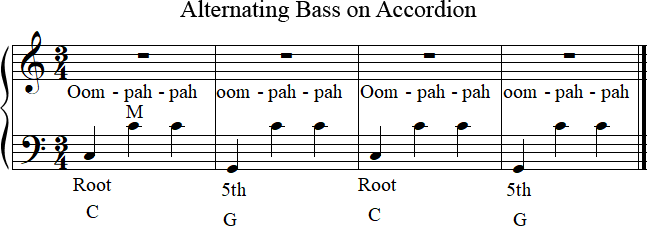
In the arrangement we are going to analyze, you will play the same rhythmic pattern except for the measures where the bass notes deviate from it. I will identify these exceptions in the following analysis.
Planning and organizing a performance
What may seem natural and effortless in a performance is often the result of careful planning and organization. Musicians strive to maximize the beauty and expressiveness of a melody, while also demonstrating their skills and/or hiding any of their limitations. A well-constructed arrangement can create a sense of climax and resolution, engaging the audience and leaving a lasting impression.
The arrangement
This arrangement in F minor for accordion by Frank Fusari, is faithful to the original melody of the song, but also adds some variations and ornamentations that make it more interesting and challenging to play. It’s suitable for intermediate accordionists but also for beginners who want to push their skills to the next level.
It includes some left-hand bass and chord progressions that add depth and complexity to the accompaniment, as well as some right-hand embellishments, triplets, and trills that add excitement and style to the melody.
Before beginning to read, take a few minutes to listen to the entire arrangement by clicking the play button:
Sous Le Ciel De Paris by FusariMusic
(Unfortunately, it seems that the embedded Musescore player is not playing the audio track as intended. However, you can still listen to the MIDI version by selecting the “Synthesizer” option. This should allow you to hear the music through the MIDI file, even if the audio track is not functioning properly.)
Or you can listen the audio track by watching this video:
If you need to slow down the audio track, you can use the YouTube video player function to adjust the speed. Simply click on the gear icon in the video player and select a slower speed from the dropdown menu. This will allow you to hear the track at a speed that is more comfortable for you.
Deconstructing a score
Deconstructing a score by dividing it into sections and identifying the various elements of the arrangement may seem tedious and complex, but it is a crucial step in understanding and improving your performance of any piece. By breaking down the score in “parts”, you can better understand the structure, melody, and accompaniment of the music, as well as the technical and harmonic challenges presented by the arrangement. This process can help you to identify any areas that may require additional practice or attention, as well as to develop strategies for learning and performing in a better way.
Structure
In this arrangement we have:
- Intro
- Part 1 (2 times)
- Part 2
- Part 1
- Part 3
- Part 1 (2 times – change of register)
- Part 2 (variation with triplets)
- Part 1 (ending)
Intro
The first 8 bars feature a repeated series of four arpeggios, accompanied by a descending bass line (F, Eb, D, C). This creates an engaging opening to the song, setting the stage for the main melody.
For the first three measures you have to play an F minor while moving the bass note from F to D before going on a C7:
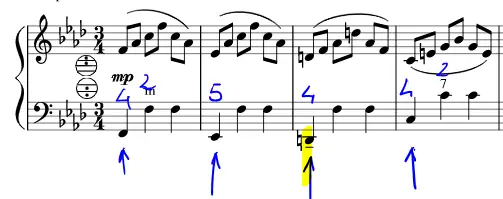
An alternative common way to write the same progressions is this:
- F min
- F min/Eb
- F min/D
- C7
F min/Eb and F min/D are known as “slash chords“ which means that the first element represents the chord and the second element after the slash, represents the bass note.
Part 1 – Main theme
The main theme is played two times (from bar 9 to bar 39).
After the first three bars of the theme, you can see a similar bass progression as the intro, on bars 12 and then on bar 28, but this time it starts on C and ends on F (C, Bb, Ab, G, F).
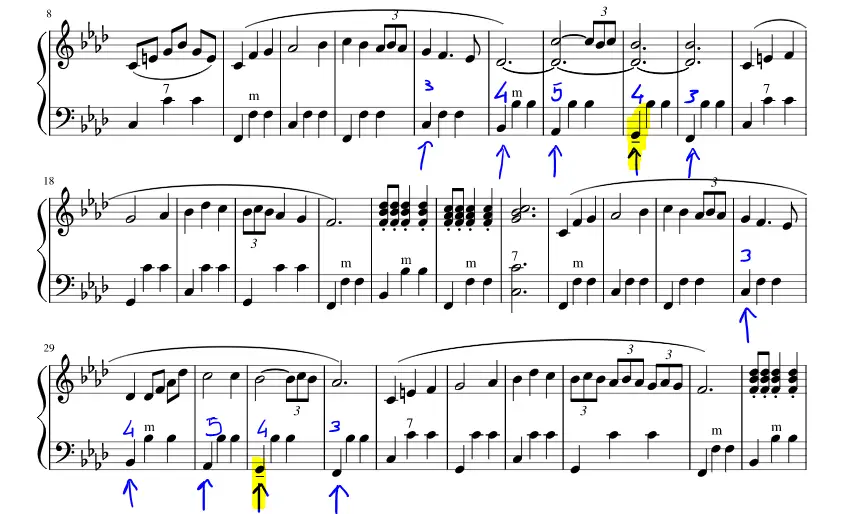
Part 2
The second part starts at bar 40 and ends at bar 56. Pay attention to the right-hand chords played as a rhythmic embellishment over a series of long notes. This type of rhythmic and harmonic ornamentation makes the long notes less dull and more interesting to the listener.

Suspend the alternating bass from bar 49 up to bar 52: as you can see, the roots (Db in bars 49 and 50, Bb in bars 51 and 52) are repeated in two consecutive measures, disrupting the alternating bass pattern.
On bar 53, on the trill, there’s another bass progression that starts in C and it ends in F on bar 57, where the main theme starts again.

If you prefer slash chords, here’s the sequence:
- C7
- C7/Bb
- C7/Ab
- C7/G
- F min
Part 1 ends in F Major
After the second part, the main theme starts again but this time, instead of repeating itself, it goes into an F major chord which introduces the third part.
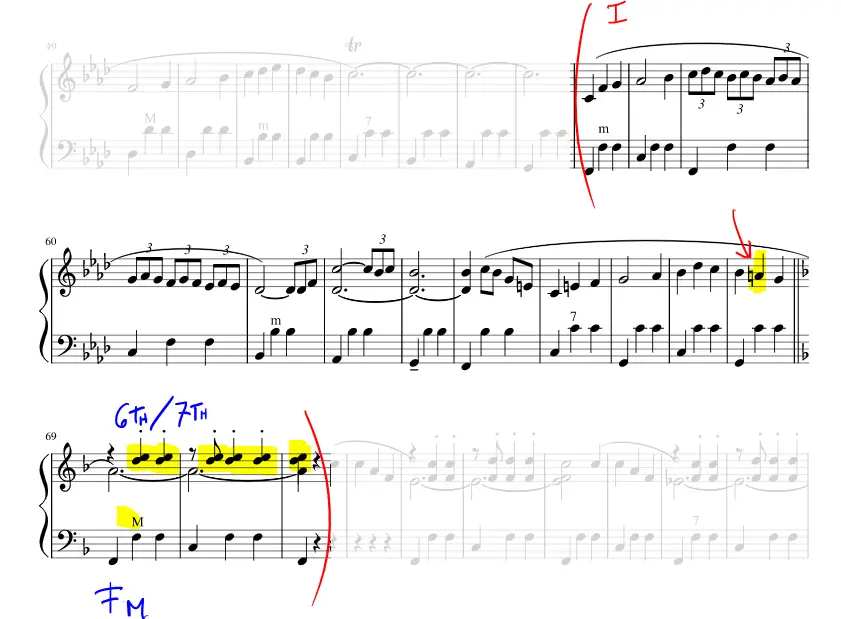
The D and E notes in bars 69, 70, and 71 add a 6th and a major 7th to the F Major chord played by the left hand on the accordion. It’s another little harmonization that brings a nuance of color to the performance.
Part 3
The third part goes from the last quarter of bar 71 to bar 104 part and is pretty simple.
Focus on the measures where you have to play rhythmic ornamentation (highlighted in yellow), as they truly add a different flavor to the long notes of the melody.
Feel the power of the progression that starts at bar 89 and ends at bar 99. Beautiful! (Don’t forget to suspend the alternating bass on bars 97 and 98).
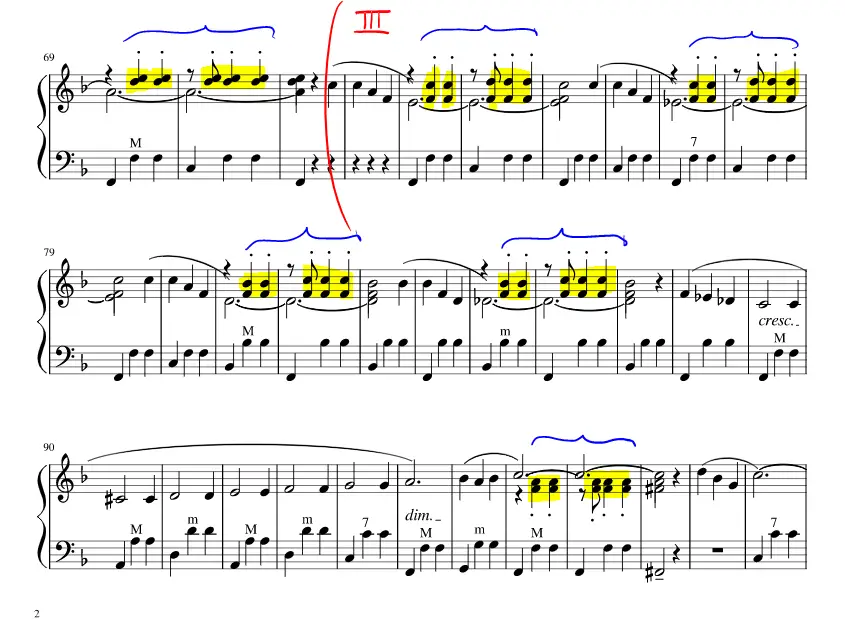
Dots: When in music notation a dot is placed above or below a note or chord, it indicates that the note or chord should be played “staccato”. Staccato is a musical term that refers to a way of playing in which notes or chords are played in a “detached” and “separate” manner, rather than being smoothly connected.
Part 1 – Switching register
Changing the register of your accordion is another way to add variety to your performance. Although the part is the same as the ones you have already played, a different register will add a new level of excitement and interest. By switching registers, you can create a sense of variety and contrast, and keep your audience engaged and attentive. Whether you choose a high, bright register or a low, mellow register, changing registers can add a new dimension to your playing and help make your performance more dynamic and expressive.
In this arrangement, the composer suggests using the register known as bandoneon, but you can choose any register that you like.

Personally, I would choose the violin/musette register, but the choice is up to you. By experimenting with different registers, you can add color and interest to your performance.
Tip: Switching registers during a performance can be a challenging task, and it is important to practice this skill in order to execute it smoothly and on time. If you don’t practice switching registers, you may forget to do it during your performance, or worse, you may accidentally press the wrong register switches. By practicing, you can develop muscle memory and proficiency, and ensure that you are able to do it with confidence and ease.
At bar 120, the score tells us to play a C7 chord (consisting of C, E, Bb) with the left hand, and a trichord (G, Bb, Eb) with the right hand.
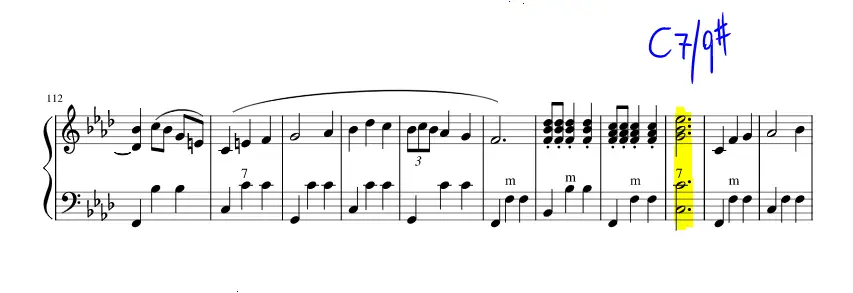 The combination of these notes results in a C7/9# chord (C, E, G, Bb, D#), in which:
The combination of these notes results in a C7/9# chord (C, E, G, Bb, D#), in which:
- C serves as the root,
- E as the major 3rd,
- G as the perfect 5th,
- Bb as the minor 7th,
- Eb as the sharp 9th (D#).
It’s a cool harmonization: 7/9# chords are quite dissonant due to the presence of the major 3rd and the sharp 9th, so if it seems too harsh at first, it may just be a matter of getting accustomed to it. Otherwise, you can choose to play a different chord, it’s up to you.
Note: Notice that in the audio track, on bar 120, Frank plays C+Eb Major instead of C+C7 resulting in a Cm7 chord instead of C7/9# chord. He told me that the right chord on bar 120 is Cm7 and that the C7 on the score is a misprint. Anyway, I like the misprinted C7/9# so feel free to choose the chord you prefer.
Part 2 – Triplets variation
In this section, we repeat the second part, but instead of playing long notes with rhythmic embellishments, we now play triplets.
Triplets are groups of three notes that are played in the same time as a quarter note, giving them a playful and rhythmic pulse. By incorporating triplets into your playing, you can add an exciting variation to the melody.
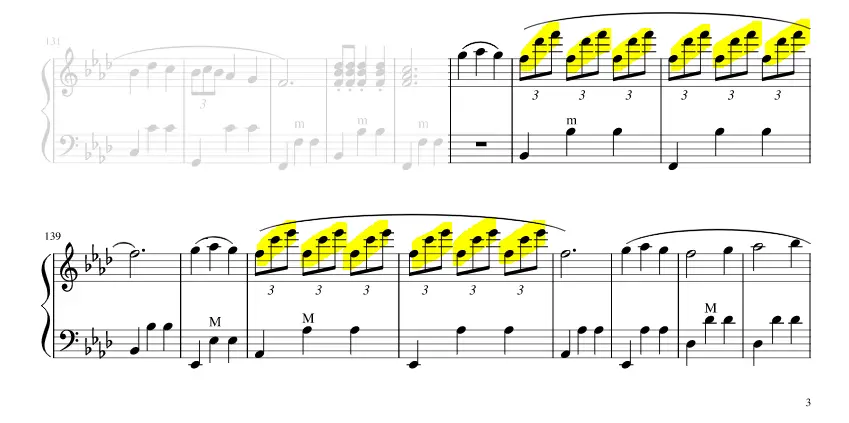
Part 1 (octave variation) – Ending
Another trick to add variety to the repetition of the main theme is to raise the melody by an octave. This variation can be especially effective when used at the end of a piece, as it can provide a sense of climax and leave a lasting impression.

The chord on the final bar is a minor 7th chord and it consists of a root note, a minor 3rd, a perfect 5th, and a minor 7th.
The score tells us to play an F minor with the left hand and a trichord (Ab, C, Eb) with the right hand. The combination of these notes, F, Ab, C, Eb creates an Fmin7.
If you prefer, just end with an F minor, or try to play with your right hand the first inversion of Fm6 (Ab, C, D, F) or Fm6/9 (Ab, C, D, G). They are both good choices for an ending.
Conclusion
Reading and studying sheet music is an essential skill that can help you improve your playing and expand your musical horizons. Sheet music provides a written record of the melodies, harmonies, and rhythms, allowing you to learn and understand music in a more systematic and structured way.
By studying sheet music, you can learn new techniques, develop your musical ear, and gain a deeper understanding of the music you play. Furthermore, sheet music is an endless resource, providing an almost limitless supply of new pieces and ideas to learn and explore. By understanding the structure and theory behind the music you are playing, you can become a more confident and skilled musician, capable of interpreting and performing a wide range of musical styles and genres.
Through my analysis of “Sous le ciel de Paris”, I showed descending bass lines on fixed chords, rhythmic ornaments played with chords, and simple variations such as changing registers or playing an octave higher.
In conclusion, I hope that this article has provided you with new ideas to improve your performances on the accordion and if you are not yet familiar with reading music, hopefully, it has motivated you to start learning.
Happy practicing!
Author: Giovanni Lucifero
If you enjoyed this post, please share it with your friends and followers on social media. Let’s spread the knowledge and inspire others to learn and grow together.
Is there a way to email questions to accordion chords.com?
Yes, you can send any questions directly to me using the contact page here:
👉 https://accordionchords.com/contact/
I’ll do my best to reply as soon as possible!
Thank you for this excellent tutorial.
I would like to practice and master as you instruct.
How does one obtain a copy of the sheet music? Please advise.
Thank you very much.
Thank you for your kind words!
I’m glad you found the tutorial helpful! You can find and download the sheet music at the following link:
👉 https://musescore.com/fusarimusic/scores/5513641
Happy playing, and feel free to reach out if you have any other questions!